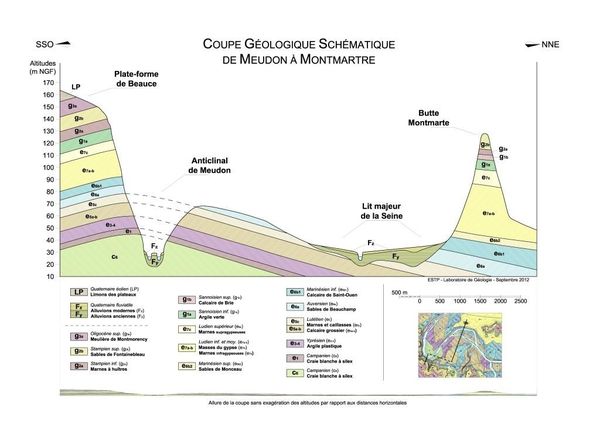

 On ne peut observer les roches qui le constituent qu’en de très rares endroits, comme aux Buttes-Chaumont ou à la faveur d’excavations momentanées, creusées en vue de divers travaux. Cependant, grâce aux carrières souterraines et aux multiples galeries forées par l’homme, le sous-sol de Paris est bien connu. La comparaison de la disposition des couches de terrain qui constituent la butte Montmartre permet de conclure que le sous-sol parisien est constitué de strates à peu près horizontales. Le calcaire de Saint-Ouen, qui couvre la montagne Ste-Geneviève est à une altitude voisine de celle du même type de calcaire sur lequel repose la butte Montmartre.
On ne peut observer les roches qui le constituent qu’en de très rares endroits, comme aux Buttes-Chaumont ou à la faveur d’excavations momentanées, creusées en vue de divers travaux. Cependant, grâce aux carrières souterraines et aux multiples galeries forées par l’homme, le sous-sol de Paris est bien connu. La comparaison de la disposition des couches de terrain qui constituent la butte Montmartre permet de conclure que le sous-sol parisien est constitué de strates à peu près horizontales. Le calcaire de Saint-Ouen, qui couvre la montagne Ste-Geneviève est à une altitude voisine de celle du même type de calcaire sur lequel repose la butte Montmartre.
 We cannot observe the rocks which constitute it that in very rare places, as in Buttes-Chaumont or thanks to momentary excavations, dug with the aim of diverse works. However, thanks to the subterranean careers and to the multiple galleries drilled by the man, the basement of Paris is well known. The comparison of the arrangement of the layers of ground which constitute the mound Montmartre allows to conclude that the Parisian basement is constituted by strata more or less horizontal. The limestone of Saint-Ouen, which covers the mountain St-Geneviève is for a nearby height of that of the same type of limestone on whom bases the mound Montmartre.
We cannot observe the rocks which constitute it that in very rare places, as in Buttes-Chaumont or thanks to momentary excavations, dug with the aim of diverse works. However, thanks to the subterranean careers and to the multiple galleries drilled by the man, the basement of Paris is well known. The comparison of the arrangement of the layers of ground which constitute the mound Montmartre allows to conclude that the Parisian basement is constituted by strata more or less horizontal. The limestone of Saint-Ouen, which covers the mountain St-Geneviève is for a nearby height of that of the same type of limestone on whom bases the mound Montmartre.

 Les roches du sous-sol parisien peuvent être regroupées en trois ensembles, suivant l’origine du sédiment à partir duquel elles se sont formées :
Les roches du sous-sol parisien peuvent être regroupées en trois ensembles, suivant l’origine du sédiment à partir duquel elles se sont formées :
- Les roches d'origine marine : sable de Fontainebleau, sable de Beauchamp, calcaire grossier, craie, ainsi que certaines marnes.
- Les roches d'origine lacustre : calcaire de Brie, calcaire de Saint Ouen.
- Les roches d'origine fluviatile : Argile plastique, gypse et certaines marnes.
Le sous-sol de Paris est donc constitué de roches formées à partir de sédiments déposés dans l’eau, ce qui explique la présence des strates horizontales.
 The rocks of the Parisian basement can be grouped in three sets, following the origin of the sediment from which they formed:
The rocks of the Parisian basement can be grouped in three sets, following the origin of the sediment from which they formed:
- The rocks of marine origin: sand of Fontainebleau, sand of Beauchamp, unrefined limestone, chalk, as well as certain marls.
- The rocks of lakeside origin: limestone of Brie, saint Ouen's limestone.
- The rocks of fluviatile origin: plastic Clay, gypsum and certain marls.
The basement of Paris is thus constituted by rocks formed from sediments put deposited in the water, what explains the horizontal presence of strata.
CONDITIONS POUR LOGUER LA CACHE :
 Pour pouvoir loguer cette cache, vous devez m'envoyer par mail les réponses aux questions suivantes :
Pour pouvoir loguer cette cache, vous devez m'envoyer par mail les réponses aux questions suivantes :
1/. Quel est la hauteur de la butte ? Pour cela vous pouvez prendre l'altitude en bas et en haut de la Butte (WPT1 et WPT2).
2/. Que contient la pierre qui constitue le mur de l'église Saint Pierre? (WPT3)
En option, vous pouvez joindre à votre log une photo de vous et/ou votre GPS devant ce mur.
3/. Au WPT4, vous pouvez visualiser une partie de la coupe de la butte, a votre avis quel type de strate visualisez vous ? Pour vous aider, vous êtes devant l'entrée de l'ancienne galarie d'xploitation souterraine.
- a - Argile
- b - Gypse
- c - Sable de Fontainebleau
 To be able to log this earthcache, you must send me by e-mail the answers to the following questions :
To be able to log this earthcache, you must send me by e-mail the answers to the following questions :
1 /. What is the thickness of the visible outcrop? For it you can take the height below and at the top of the Coast (WPT1 et WPT2).
2 /. What contains the stone which constitutes the wall of the church Saint Peter? ( WPT3)
Optional, you can join to your log a photo of you and/or your GPS in front of this wall.
3 /. In the WPT4, you can visualize a part of the cutting of the mound, has your opinion which type of stratum visualize you? To help you, you are in front of the entrance of the old galarie of subterranean xploitation.
- a - Clay
- b - Gypsum
- c - Sand of Fontainebleau
